"It's a tad easier to be proud when you come in first than it is when you finish further back. But there's no reason to hide when you don't do as well as you'd hoped. You can't run away from your problems." -My Little Pony
It's been two weeks since our last edition of Comments of the Week here on our Starts With A Bang forum, and -- to my great pleasure -- that hasn't meant a thing for the flow of great comments here! There's plenty to catch up on if you missed anything, as the last two weeks have seen some amazing posts, including:
- Why is the Universe's energy disappearing? (for Ask Ethan),
- Space & science nail art (for our Weekend Diversion),
- The could-be-better cluster, M26 (for Messier Monday),
- CMB Part 2: The "Smoking Gun" of the Big Bang (a great contribution from Amanda Yoho),
- The Physics of Wormholes (a fantastic post by Paul Halpern),
- Nature is not symmetric,
- The surprising king of the Kuiper belt (for Throwback Thursday),
- How far does gravity reach? (for Ask Ethan),
- The little dumbbell nebula, M76 (for Messier Monday),
- Wishing doesn't make it so (a delightful article by Brian Koberlein),
- Landing at the end of the solar system, and
- Quantum Reality (for Throwback Thursday).
There's so much to catch up on that we'd better dive right in!
From PJ on the topic of the Universe's energy: "If energy cannot be created or destroyed, what form of energy existed before the BB?"
When we talk about energy being created or destroyed, we are speaking of the law of energy conservation: that you can convert it from one form into another, that you can use it to perform physical actions (like work), but you can't create it for free and you can't have it disappear into nothingness.
Before the Big Bang, the Universe existed in an inflationary state, where space was expanding exponentially. The energy that existed in the Universe was energy inherent to space itself. It was similar to the dark energy we have today, but while the dark energy density is on the order of 0.1-to-1 milli-electron-Volt today, it was on the order of 10^15 giga-electron-Volts during inflation, or 27-to-28 orders of magnitude greater! Just like the dark energy density today isn't going anywhere, neither did the inflationary energy density. The big difference is that energy was able to convert into matter-and-radiation at some point; it is not thought that dark energy density can undergo a similar transition.
 Image credit: Kristin Fredriksen, via http://www.pinterest.com/pin/28429041373578865/.
Image credit: Kristin Fredriksen, via http://www.pinterest.com/pin/28429041373578865/.
From Anandaram Mandyam on space & science nail art: "Fantastic! You carry astronomy or any oher subject literally at your fingertips!"
Now, it's hard to imagine more impressive art than this, but the toughest pill to swallow is how transient nail polish art is. How much would you prefer these nails in a press-on variety, where you can pop them off-and-on to accessorize as you wish?
I'm not a big nail art guy, but I would totally go for some reusable space art nails!
Image credit: John Kovac, via http://cosmo2014.uchicago.edu/depot/invited-talk-kovac-john.pdf.
From Sinisa Lazarek on the CMB polarization article that Amanda Yoho wrote: "Extremely informative. This is the first time I heard someone actually explain what b-mode is (the magnetic component of EM)… which is awesome. Also, the process of how they are extracted from the rest of data is explained. I wish there were more articles from Amanda."
Do you hear that, Amanda? You have to write more!
Seriously, I'm so happy about all the contributors we have and how much their writing is enhancing what I try and bring to the world through Starts With A Bang. I'm so lucky to have such great people on board!
From G on the physics of wormholes: "If it’s feasible to find or create wormholes at all, they will likely be tiny, but potentially sufficient to serve as conduits for signals."
You know, one of the toughest considerations, when it comes to wormholes, is the necessity of using huge amounts of negative energy material to stabilize the wormhole's neck. Otherwise, whatever matter you tried to pass through it would simply be crushed-and-stretched into smithereens. Even the atoms themselves (and probably the nuclei as well) would be torn asunder!
But single photons -- or any single fundamental particle, for that matter -- wouldn't be! So long as you can exit the wormhole on the opposite end you entered it from, you should be able to transmit photons without a problem: and hence, you could feasibly use it as a way to circumvent the speed-of-light barrier for communications. One of the most seemingly far-fetched technologies from Star Trek, sub-space communications (since sub-space doesn't exist), would have its functional equivalent become reality.
 Image credit: http://www.trekp.com/posters/gw222-subspace.jpg.
Image credit: http://www.trekp.com/posters/gw222-subspace.jpg.
Now, I'm still not convinced, mind you, that wormholes, simply because they're mathematically possible, are physically possible for our Universe, but if they are, this ought to be the first and most conservative application to emerge from them. And how amazing would that be?
Image credit: Ed Murdock of http://www.technologyinenterprise.com/blog/2013/08/15/magnetic-monopole….
From Gary S on the asymmetry between electric and magnetic forces: "A “magnetic field” is only one interpretation of the relativistic effect of a moving charge. Einstein showed in his 1905 paper “On the Electrodynamics of Moving Bodies” that magnetic forces between two differently moving charges would disappear if the frame of reference was moving along with either of the charges. At the end of Section 6, Einstein offered the two choices of interpretation, one being the (old) view of magnetic forces."
One of the fun things you learn to do when you get to electricity and magnetism at a more advanced level is how much fun you can have if you change your perspective. What do I mean by changing your perspective? There are two things here:
- Choosing your frame of reference, meaning the velocity field that you call your "rest frame."
- Choosing your gauge, meaning that you have some freedoms for the fields and potentials that lead to your physically observable electric and magnetic fields.
Consider that your magnetic field and electric field, as you can see above, are derived from charges (sources) that may or may not move (create currents), and how the fields themselves change over time. What you learn is that you can take any scalar field that's a function of space and time, and so long as it obeys certain properties, you can add it to your electric and magnetic potentials without changing the fields.
 Image credit: Xiaofei Xu, Yijun Feng and Tian Jiang, via http://iopscience.iop.org/1367-2630/10/11/115027/fulltext/.
Image credit: Xiaofei Xu, Yijun Feng and Tian Jiang, via http://iopscience.iop.org/1367-2630/10/11/115027/fulltext/.
By combining these two properties, you can turn a purely electric effect into a combination of electric and magnetic ones, or a purely magnetic effect into a combination of electric and magnetic ones, or sometimes a combination of electric and magnetic effects into solely either an electric or a magnetic one.
But this was not a newfound discovery of Einstein's, but rather was a consequence of Maxwell's equations that was known for over 40 years before Einstein's special relativity came along. Fun stuff, no matter how you slice it!
From Physicalist on the topic of the Kuiper belt: "I’m still sad that they took away the name “Xena” and substituted “Eris.”"
If you want a clever acronym, you should always go to an astronomer. If you want a clever name for an astronomical object, you're going to have to work very hard to slip one past that goalie. Which is to say, the IAU is one of the least fun groups out there: think the Strunk and White of space. And for those of you who don't know what I'm talking about, here's what Dorothy Parker had to say about Strunk and White:
If you have any young friends who aspire to become writers the second-greatest favor you can do them is to present them with copies of The Elements of Style. The first-greatest, of course, is to shoot them now, while they’re happy.
Image credit: David Champion, via http://www.ast.cam.ac.uk/research/cosmology.and.fundamental.physics/gra….
From Michael Kelsey on the reach of gravity: "If the graviton were massive, then it would have a shorter range: it would fall off exponentially with distance. In fact, the experiments being done at the University of Washington (and elsewhere), which look for deviations from 1/r^2 behavior, can be interpreted as setting limits on the mass of the graviton."
And this is a hint of the more detailed explanation of the fact that the range of a fundamental force is determined by the mass of the particle mediating that interaction. (At least, assuming that your force lives in 3 spatial dimensions!) If your particle mediating that force is massless, your force falls off as 1/r^2, which is what we call an infinite range force. This is why it's so important (in theory) that the photon and the graviton are truly massless! It's also why looking for extra dimensions is so interesting; if instead of 3 dimensions, we had n-dimensions to our space, then the force laws would behave as 1/r^(n-1), which means that we should see a departure in how the gravitational force works on small scales. (We have verified that there are no extra dimensions down to the micron-level, FYI, but no further.)
 Image credit: R Nave of http://hyperphysics.phy-astr.gsu.edu/hbase/forces/funfor.html#c2.
Image credit: R Nave of http://hyperphysics.phy-astr.gsu.edu/hbase/forces/funfor.html#c2.
This explains why the strong force between protons and neutrons in a nucleus (mediated by pions, of about 140 MeV apiece) is such a short range force, and why the weak interactions (mediated by 80-to-91 GeV gauge bosons) are even shorter range! But so long as the graviton truly is massless -- and the Universe really does have three spatial dimensions -- the "range" of the gravitational force is limited only by the speed of light and how long the Universe has been around!
From MandoZink on the fictions of science fiction: "The ever-popular science fiction theme of a time machine has one serious flaw (among likely many others). Spatial dislocation following temporal relocation is always conveniently ignored, yet it’s consideration is paramount."
You must remember that the Earth orbits around the Sun at a clip of 30 km/s, the Sun and solar system revolve around the galaxy at about 200-220 km/s, the galaxy hurtles through space at around 300-to-600 km/s relative to the other things around it, and yet somehow, when people travel years or aeons back (or forward) in time, they always wind up in the same exact location they began in.
How much more likely it would be for them to end up in the vast emptiness of space, or -- if not -- the interior of a planet or star, than on the surface of the world they began on?
I suppose we simply have to assume that's something already accounted for, but I agree, most people don't account for it (or even mention the need to account for it) at all in their fiction.
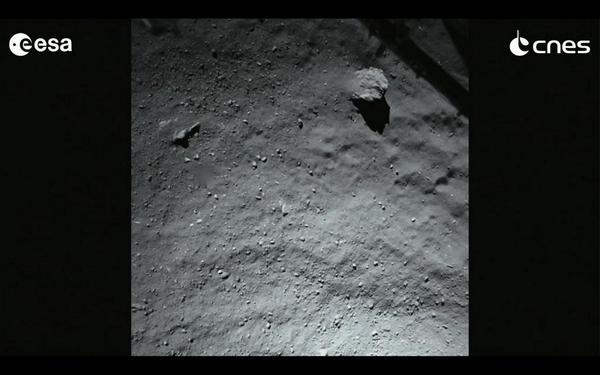 Image credit: ESA / CNES / Philae, via https://twitter.com/ObservingSpace/status/532596055783661568/photo/1.
Image credit: ESA / CNES / Philae, via https://twitter.com/ObservingSpace/status/532596055783661568/photo/1.
From eric on the topic of Rosetta's Philae lander: "Latest update from CNN coverage is that Philae’s battery is expected to last until Saturday or Sunday (because of less sunlight hours). The research team is going to take the standard strategy of not messing with the position, collecting all the low-risk data they can for as long as they can. They will only try high-risk strategies like moving it or jostling it into a better position after they have collected a lot of data and the batteries are almost dead."
There was a double-equipment failure of the retro-rockets not firing and the harpoons not firing that led to the lander bouncing so many times and so far off-course. It still landed on the comet, but fell into a shadowed region where it gets only one fourth of the sunlight it needs to power its solar panels.
I have said this before and I'll say it again: if you want a reliable source of power that isn't contingent on everything working perfectly, solar panels are a fool's game. Bring your own: go nuclear!
This was the biggest difference between the power source of the Spirit/Opportunity rovers and the latest Mars rover: Curiosity. It's amazing that the Opportunity rover is still going, and that Spirit lived for so long. But part of why Spirit got stuck was its tremendous power loss over time, and that was related to its inability to free itself. Opportunity may yet go even longer, but Curiosity has enough nuclear power for a full human lifetime of operations.
And if we weren't such chickens about launching radioactive material into space, Philae could have done what it needed to do regardless of the amount of sunlight we got. Maybe someday we'll finally get over our NIMBY nuclear fears.
 Image credit: Science Daily via Texas Tech, at http://www.sciencedaily.com/releases/2014/11/141112131927.htm?utm_sourc….
Image credit: Science Daily via Texas Tech, at http://www.sciencedaily.com/releases/2014/11/141112131927.htm?utm_sourc….
And finally, from David Hurn on quantum reality: "I believe there is a[n] objective reality, so many of the “interpretations” will be shown to be false in the future, if not now."
And the first statement is fine, but whether it's at all connected to the second statement is highly debatable. Whether or not there is a singular objective reality is something you're welcome to believe it, although it may or may not be true, as different quantum interpretations are consistent with either one. (I don't think it is true, but that's not proven.)
But can we, in principle, distinguish between many of these interpretations? We don't think so. And that means that showing an interpretation to be false may be an incredible, insurmountable task!
Thanks for a great week of comments, everyone, and make sure you come back next week for an incredible opportunity that I'll reveal then!
- Log in to post comments

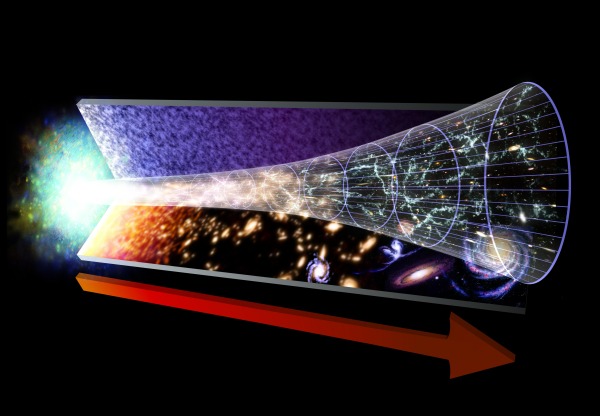
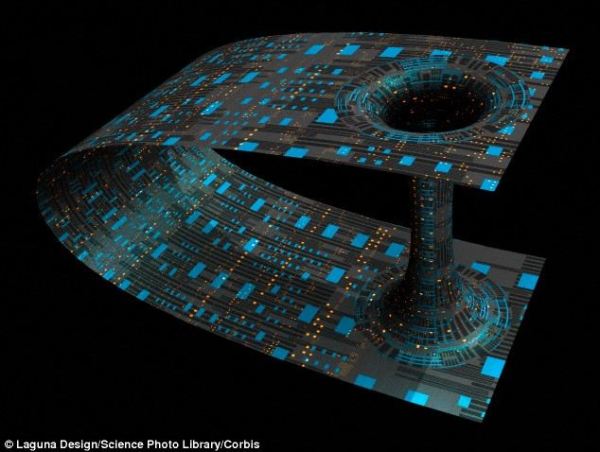
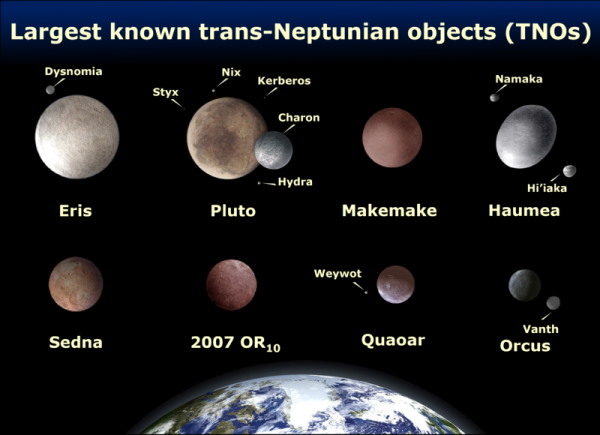
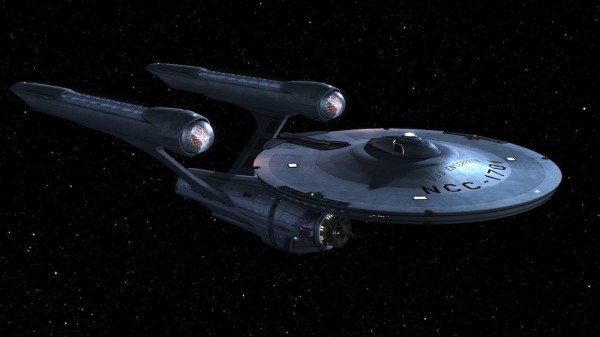

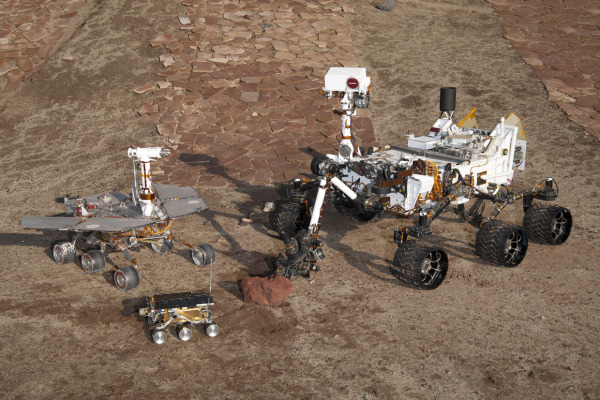
Hi Ethan thanks for the reply.A couple of hundred years ago flying to the moon would have been an "incredible, insurmountable task",(some idiots still don't believe it).
I think that in a short period of time we will devise a experiment to show if a pilot wave actually "steer's" the electron in it orbit,or not.
I was not trying to imply that there is a singular reality everywhere but there does appear to be one in our local area of space.
Spatial displacement due to time travel is easy enough to deal with. You just need the right crystals: http://www.atomic-robo.com/free-comics/fcbd09/